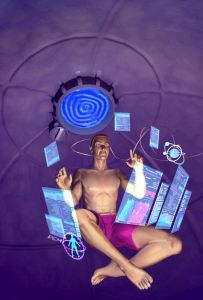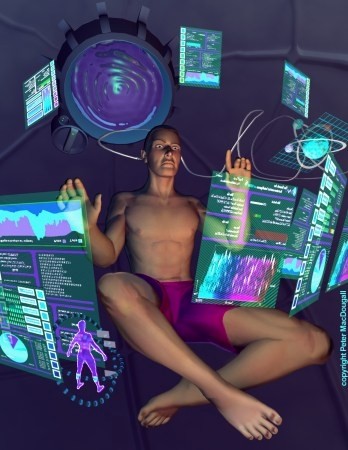
Saint Judy's Comet
Copyright © Peter MacDougall, all rights reserved
Saint Judy's Comet is a 10,200 word speculative fiction story . It is based on an original concept by Chris Brayshaw, author.
Above is an illustration for Brian Briscoe, systems Engineer. Click on the image for more details.
Part II
At seventeen hundred Lunar Time, Captain Zofia Szulc watched six new crew members go aboard the Faster-Than-Light ship Orlando that was high above Ceres Crater. Above Zofia, Earth shone clear and blue in the darkness.
The Orlando was a micro FTL ship, a scout. From the outside, she looked like a squat ellipse, truncated at each end. Around her perimeter, four semi-spherical bulges were staggered evenly along her mid-line. Inside the craft, the lines of the bulges came together to form true spheres, anchored firmly to a hidden central sphere.
From her extra-vehicular position, Zofia could see her support crew still grappling over the ship's exterior. The Orlando was Zofia's ship, technically, but for the sake of this holiday visitor, her veteran crew had been scrubbed and replaced. By a group of misfits, Zofia thought.
Zofia knew a few of her crew still lingered behind, obsessively tinkering with detail inside. She checked the virtual Heads-Up Display and scanned the transparent ship projected before her.
The ship's four spheres were re-modified for each crew member. Each person would spend the duration of the trip in their own "well", surrounded by equipment directly related to their mission goals, breathing a hyper-oxygenated fluorocarbon emulsion designed to protect them from the massive inertial and gravidic tidal forces of FTL travel.
Brian Briscoe, the Systems Operator, was already in his well, jacked into the system through a fibre-optic umbilical. Zofia's HUD overlaid his visual with a précis of his systems check data. She had met him briefly a few weeks ago. Jerk.
Zofia looked towards the others. The HUD had trouble identifying !Tp, the alien astrophysicist in anything more complex than flat geometric shapes. The alien was in its well already and connected by its own interface. According to the rumours, it was unhappy to be selected for the mission, but it would not argue with its upper "caste" who insisted on having a representative at what might be the Second Contact for each species.
Canj Splinya, the team geophysicist and chemist, was entering her well and only sparse data came in on her. She had been moonside, heading the excavation at site 31, when she had been called up for the mission.
Chula Song-Lai was still disembarking from the inter-ship shuttle. Two of ARES station's corporate sponsors, IBM and PanAm, had flown her up from Alberta for this mission. No-one here knew her at all.
In the core of the ship was the FTL drive, the Artificial Intelligence, and the spherical well for the two dolphin pilots, Swims-warm-seas and Dives-by-reefs<.
Zofia adjusted the level of complexity her HUD displayed for the dolphins. The links between the dolphins and the ship were extensive and complex. Their well was designed to feed them sensations from the ship, echoes, sounds, in patterns familiar to them. In effect, the dolphins "became" the ship, steering it through space as they might steer themselves through water. Zofia knew these two to be better pilots than most; they were hers.
Finally, Zofia looked deep into the ships squat dense base. There, was the drive itself: a combined Fourier-Hanson transformer and dedicated quantum level computer -- a black hole and an 'ice box' -- all in working order according to her HUD.
She checked her WatchMan by reflex. By now, the dolphins would be helping the technicians with the last of the system checks on the drive itself.
The plan was for the Orlando to jump close to the visitor, track it for up to six hours, then jump home again. Because the trip was a short one, the consensus had been that there was no need to select individuals who had worked together. Only the dolphins and Brian had ever met before. For such a short simple mission, each one would operate independently, busy with their own tasks, linked only by the AI, if at all. It was an arrangement that Zofia had strongly argued against, favouring her own experienced, integrated crew.
An alarm went off and her HUD lit up one of the wells in the Orlando. It was the xenologist, Song-Lai. She had just began to enter her well. Her blood pressure, heart rate and respiratory rate were climbing.
Zofia linked with her crew aboard the ship. "Drowning Rat. Well 3," she said into her throat mike. Quickly, two more of her crew joined their ship-mate who was struggling with Chula Song-Lai. They brought her back out of the well and began the standard emergency surfacing protocol.
Untrained. Unprepared. Zofia remembered her reaction when she had first tried breathing a liquid atmosphere. It took a lot of training to get used to it. How could they have expected a land-lubber like Song-Lai to cope with breathing liquid on the first try?
The crew finally calmed Song-Lai down and cleaned her up. They adjusted her interface and guided her back into the well. Everything went fine. Too smoothly, in fact. They must have manipulated her interface to get her to co-operate. Officially, she would probably have to reprimand them.
The emergency resolved, Zofia was left to supervise the arrangement of the feed mass beside the Orlando. The energy required to generate the black hole necessary for FTL travel was enormous, even for her small craft. When the requisite energy was not immediately available, mass would do. Typically, asteroids, space refuse, or any other expendable mass was used. For emergencies like this, moon material would be diverted from the Ceres Crater mass drivers. Her own mission would now be delayed for weeks until enough mass could be collected for another flight.
The Comet mission crew was given little time to arrange themselves in their wells before the support ships began un-docking. Zofia relayed orders via her suit telecom system to the remaining support staff. System checks were run by remote in an effort to minimize the time to transfer. Like petals shaken from a flower, the EVM's, support crew, and connectors fell away from the Orlando.
Once Safe Radius was achieved, the whole community of insystem and outworlder support crew turned to watch the ship's departure. Empty moments passed as the multiply-redundant launch programs stepped through their instructions. Zofia checked her display briefly and looked up at her ship just as the countdown finished.
The mass beneath the Orlando puckered and disappeared. The space surrounding the base of the ship seemed to dilate. Stars stretched and moved as if on the surface of an expanding balloon. Then the Orlando tilted on the edge of the expanding gravity lens and disappeared. The flat black backdrop of space snapped back into place. A split second later the monitors flared with a brief burst of static, and the surrounding support mech shuddered with the passing gravity wave.
It was a routine launch, no glitches. Smooth as space, thought Zofia, Should have been us.











